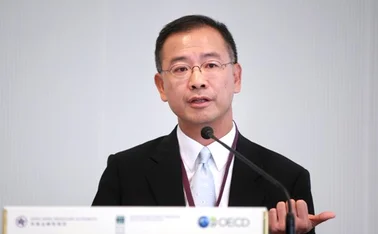
Justin Lin on China, economic growth and the international monetary system
Former World Bank chief economist talks to Christopher Jeffery

You like to use changwu – seeing the world through the eyes of a baby with no preconceived notions – when assessing a situation. What is the benefit?
All theories are based on observations of phenomena in the past and these theories are often used to explain what will happen in the future. We also know the validity of any theory depends on assumptions. But there is no guarantee the assumptions suitable for the past will be suitable in the current or future situation, especially in such a rapidly changing world. In addition, phenomena can appear to be similar but the mechanisms for triggering the phenomena may be different – we need to be very cognisant about this possibility. So, to have a really good grasp of the nature of the causes of a phenomenon, there is a need to start from scratch.
That is the approach emphasised by Adam Smith. The full title of his defining work is An inquiry into the nature and the causes of the wealth of nations. At this time trade and divisions of labour were the most important causes for the increase in a nation’s wealth. They are still important and there are many other important causes, such as technological innovation and industrial upgrading. So every time I try to understand a phenomenon taking place in the world, I look into the nature and the causes of the phenomenon. That approach is what I call changwu.
When you look at the world’s financial, economic and monetary system using changwu, what looks most out of place?
The most important challenge in the international monetary system is the inherent conflict of a reserve currency country’s national interests and global interests, and the lack of a disciplining or restraint mechanism regarding the behaviour of the reserve currency countries. We recall unhelpful stances such as that adopted by former US Treasury secretary John Connally, who said, “it’s our currency, but it’s your problem”.
Do you blame financial deregulation and low Fed interest rates following the dotcom bubble for the rapid leveraging of US dollar funding that flowed outside the US for creating the conditions for the Great Recession?
Yes, this is based on empirical facts. We observed a global imbalance before the global crisis and people often use correlation as causality and then point the finger at global imbalances, blaming it as the cause of the crisis. But, as explained in my book, Against the consensus, the global imbalances were the result of over-consumption in US households arising from the wealth effect due to the housing and equity bubbles that were the result of excess liquidity generated by the high leverage made possible by the financial deregulation in the 1980s and the low interest rate policy after the ‘dotcom’ bubble in 2001. The US could sustain the imbalances on such a large scale and for such a long time before the 2008 crisis only because the US dollar was the major global reserve currency.
How does one prevent such a situation?
It is very hard because every national government addresses domestic issues as its first priority in designing policies – no matter if it is in the US or elsewhere; or if it is monetary, fiscal or social-political policy. That is the nature of things, which is the reason we need to look into other alternatives. At present, the most commonly entertained alternative is the special drawing rights (SDR) of the IMF. But SDRs are still a basket of national currencies, and their use will not remove the conflict between the national interest and the global interest of the reserve currency countries. Some people say, ‘if we have multiple reserve currencies, then at least there is some competition, and competition can act as a discipline’.
Why will that not work?
The precondition for this hypothesis to be valid is that the domestic economies are healthy and there are no structural problems in all the reserve currency countries. If we look forward, in the coming decades, all the major reserve currency countries look as if they will have structural problems due to their inability to carry out necessary structural reforms to cope with legacy issues of past crises. Even if China, which so far has faced no systematic financial crisis, becomes the largest economy in the world, it is still a developing country measured by per capita income. This means its financialisation cannot be as deep as that of the high-income countries. In addition, it also faces structural problems. So that leaves room for all kinds of speculation among the reserve currency countries. Given the current situation, a multiple reserve currency system might be even less stable than one based on a single currency and if there is a lot of speculative activity, the reserve currency countries could also be hurt by an excessively volatile currency. So the reserve currency countries are also losers. From my analysis, a multiple reserve currency could be even less stable, so we need to think of an alternative approach.
What looks like the best alternative approach to you?
I propose in Against the consensus, replacing the international monetary system with a global reserve currency called paper gold (p-gold). Appropriately designed, an international currency can avoid the conflicts inherent in using national currencies as an international reserve currency, and it can have some of the desirable properties of precious metals used for that purpose, while avoiding the limitations that inadequate growth in supply imposes on global liquidity.
P-gold, as I propose, has the flexibility of paper money, in that it could support liquidity growth as the global economy expands, but that – similar to a commodity like gold – would be ‘outside’ the system of national currencies. This offers stable exchange rates without the deflationary tendency of the gold standard. In addition, it would eliminate the inherent conflict of interest between reserve currency countries’ domestic policy concerns and the global public good of economic stability. This new currency would have the advantages of fiat paper money, plus the stability of gold, so could be called p-gold (paper gold).
What do you think of the argument that US domestic policies not only have spillover effects for third-party nations but also spillback effects for the US?
That depends on the time horizon of the politicians. Politicians nowadays worry about what happens today and tomorrow, instead of what happens in the coming decades. There is a lack of discipline, especially in the major reserve currency countries. Due to the lack of structural reforms, the major reserve currency countries are likely to maintain slow growth and a high unemployment rate for an extended period, as happened in Japan after the bursting of its housing and equity bubbles in 1991. The government’s deficits will be large due to the need for social spending for the unemployed. The government’s deficits will be monetised eventually. The government has a choice to print the money to support the unemployed or to support investment in infrastructure, which creates jobs in the short run and increases productivity in the future. I think supporting investment in infrastructure would be a much better use of resources.
How large are some of these infrastructure requirements?
The Euro 2020 Project Bond Initiative project stated European countries might need to have €1.5 trillion investment in the years between 2010 and 2020. In the US, there are some estimates showing that close to $800 billion to $1 trillion of infrastructure investment is needed. Then in Asia, there are estimates that $8 trillion is required for infrastructure investments.
Can you give me any example of developed countries supporting an infrastructure project in a developing country that then fed back into positive growth for the developed country?
Well, we see power shortages in developing countries; there is a need for ports and for roads – these are bottlenecks in the development of developing countries. And they are needed almost everywhere. A World Bank study shows that for every dollar’s investment in a developing country, the country will require 70 cents of imports for the investment and half of the imports are from the high-income countries.
Isn’t China already doing a lot of this sort of investment in places such as Africa?
China has been making a lot of investments domestically and internationally, but China alone is not big enough to create sufficient stimulus to support the high-income countries’ structural reforms.
And domestically?
Chinese infrastructure is probably among the best in the developing world and those investments have supported China’s growth and created demand for high-income countries. Nobel prize-winning economist Michael Spence believes the secret of Germany’s economic miracle is the growth in China. And growth in China, especially during the crisis period with its countercyclical infrastructure investment, is one of the mechanisms helping China to maintain a relatively high growth rate, so we do see the advantages from that argument.
What do you make of the efforts of the G-20 to restore trust in the financial system, and has there been any significant advantage of having China in that group?
It is very important to understand the true causes for global issues. In the past, we often see there are some dominant views about global issues in the West, mostly originating in the US. But very often the views may not reflect the true causes. Just like global imbalances. Everyone talks about global imbalances as a cause of the global crisis, they talk about the manipulation of the Chinese currency, and high savings and high investment in China as the reasons for the global imbalances, but, in effect, this is superficial. If you look closely, those issues are not the true causes of the problem. They were just a reflection of the problem. To have China and other developing countries in the G-20 can help to provide a more balanced view about what is happening in the world, and the correct direction to address the global problems.
Unemployment is a primary concern for the leaders of China. What is the critical level of unemployment that could cause social unrest?
That is not an issue that is particular to China. For most politicians, employment is the number one goal. Also, the current unemployment rate in China is still quite low, at less than 5%, and is socially acceptable. But reasonably high growth rates are necessary to maintain the current situation. Currently, the slowdown in the growth rate is putting significant pressure on companies. They will retain employment if they have good prospects for growth in the future. And if the growth rate of the country continues to drop, there is a risk that at some point firms will start laying off the workers. My personal judgement is that it would be desirable to maintain an annual GDP growth rate above 7%. And I think there is a high likelihood for China to achieve that as there are still many good investment opportunities, for example through industrial upgrading, further upgrades of infrastructure, improvement of the environment and urbanisation. This is where China, as a developing country, differs from high-income countries. Even if we have some slowdown in the economy, there are still plenty of good investments that can be made. And, compared with other developing countries, China also has abundant resources for investment. The government’s fiscal position is strong, private saving is high and China has $4 trillion in reserves. These funds can be mobilised to support investments.
But China is trying to transform the economy from less reliance on exports to a more consumption-led economy, while still maintaining growth at 7%. Is it realistic?
I do not agree with this kind of assessment for China. In the past people have said that high savings and high investments in China were contributory causes for the global crisis. So if we want to address the issue of global imbalances and avoid a similar problem in the future, China needs to increase its consumption and reduce investment. But that thinking is a legacy of the past economics. Recently the IMF has changed its policy prescriptions and started to say it is the best time to start making investments in infrastructure.
And for China, consumption certainly is important, but if we want to increase consumption, we need to increase income. And the precondition for income increases is further improvement in productivity. And if you want to improve productivity, we need to have technological innovation, industrial upgrading and improvements in infrastructure, so investment is a precondition. If you have investment, income and consumption will also increase. Actually, the growth of consumption in China is among the most dynamic in the world. Last year, it was 9%. And the average of the past 35 years is about 7.8% – among the highest in the world. As a consumer, I do not care about consumption as a percentage of GDP; I care about whether my consumption is increasing.
What about capital account liberalisation?
Capital account liberalisation has three main components. One is liberalisation of foreign direct investment, which China started decades ago. The second component is the liberalisation of the domestic financial institutions and the enterprises to borrow internationally. And the third is the liberalisation of short-term portfolio flows. I would be very cautious about the latter two items. For the second item, the best hope is that the financial institutions and enterprises would borrow internationally to make investment in the real sector, domestically. But even that is subject to term and currency mismatches. For the third item, I do not see any added benefit to the real economy – you just open the door to speculation. We need to be very conscious about that, especially now all the major currency countries are going to have very loose monetary policy. Give the current excess liquidity in the world, capital account management will remain desirable.
Do you blame external factors for the perceived slow pace of liberalisation adopted by the People’s Bank of China?
All policies are certainly contingent on the domestic and international situation. With regard to capital account liberalisation excess liquidity in the world is one major challenge. But there are certainly some issues domestically as well. For example, if you increase deposit rates with the lending rate already liberalised, there will be a squeeze on profit margins for Chinese banks.
Is there a reform timetable?
The People’s Bank of China has said liberalisation will take place at some point in the coming two years.
Are you worried about the shadow banking market?
Shadow banking is an area where there is a need to be very cautious. The reason there was such a large increase in shadow banking after 2008 was due to concerns about the high leverage in the banking sector and regulators tried to reduce the leverage. The formal leverage of banks has now been reduced. But this forced people to borrow from the shadow banking sector.
There are three issues: first the products of shadow banking are sold through formal banks, therefore, formal banks are accountable for the repayments. Second, shadow banking is even less well regulated than bank lending. And third, the interest rate and cost of borrowing from shadow banks is higher than bank credit. So the situation has deteriorated rather than improved.
In China, the reason local financial investment vehicles are borrowing from banks, or shadow banks, is for the financing of infrastructure investment. But the best way is to use local government debt to finance those kinds of investments, so there is no term mismatch. The Chinese government is moving towards that direction, allowing local governments, at the provincial level, to issue local debts, and use long-term debts to finance long-term investments. China is moving in the right direction, as shadow banking is the one issue we need to really watch out for.
So it is a concern?
Well, it’s an issue, but I don’t think it’s going to be such a big threat in the sense that first, the total local government borrowing provided by the banks and the shadow banks as a percentage of Chinese GDP is not that big, around 20% of GDP. Secondly, they are all used for investment, so they have some assets to back them up. Also they are funded domestically rather than internationally. So there is no currency mismatch. The only issue is a term mismatch.
What about the internationalisation of the renminbi. It is still not a significant currency for trading in financial markets or as a reserve currency. Could more be done?
The size of the Chinese economy is increasing and China has become the number one trading nation in the world. There is certainly a tendency for people to use the currencies of the largest trading nations as units of account in trade. And especially, if the US dollar and euro, the two major reserve currencies, are hit by structural problems in their domestic economies, not only will it be China’s intention to make the Chinese currency more internationalised, but countries with large trade relations with China will also increasingly accept the Chinese currency as a reserve currency or as a unit of account. It will be a natural progression due to their trade rising with China.
Only users who have a paid subscription or are part of a corporate subscription are able to print or copy content.
To access these options, along with all other subscription benefits, please contact info@centralbanking.com or view our subscription options here: http://subscriptions.centralbanking.com/subscribe
You are currently unable to print this content. Please contact info@centralbanking.com to find out more.
You are currently unable to copy this content. Please contact info@centralbanking.com to find out more.
Copyright Infopro Digital Limited. All rights reserved.
As outlined in our terms and conditions, https://www.infopro-digital.com/terms-and-conditions/subscriptions/ (point 2.4), printing is limited to a single copy.
If you would like to purchase additional rights please email info@centralbanking.com
Copyright Infopro Digital Limited. All rights reserved.
You may share this content using our article tools. As outlined in our terms and conditions, https://www.infopro-digital.com/terms-and-conditions/subscriptions/ (clause 2.4), an Authorised User may only make one copy of the materials for their own personal use. You must also comply with the restrictions in clause 2.5.
If you would like to purchase additional rights please email info@centralbanking.com







